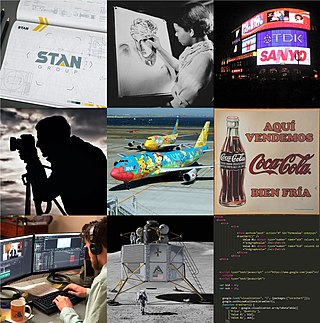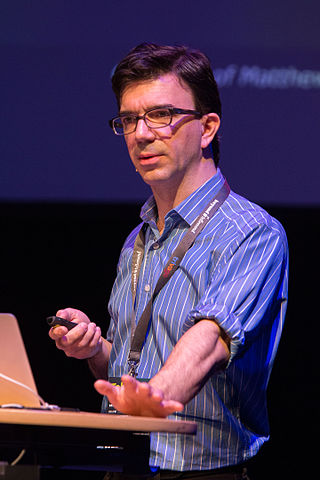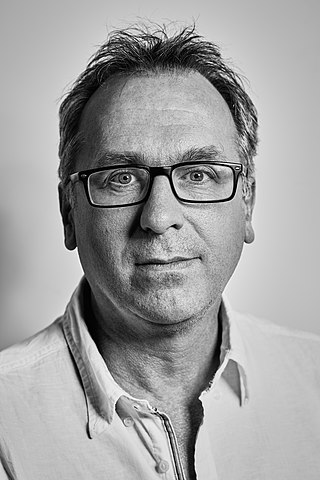Related Research Articles

Graphic design is a profession, academic discipline and applied art whose activity consists in projecting visual communications intended to transmit specific messages to social groups, with specific objectives. Graphic design is an interdisciplinary branch of design and of the fine arts. Its practice involves creativity, innovation and lateral thinking using manual or digital tools, where it is usual to use text and graphics to communicate visually.
The Minneapolis College of Art and Design (MCAD) is a private college specializing in the visual arts and located in Minneapolis, Minnesota. MCAD currently enrolls approximately 800 students. MCAD is one of just a few major art schools to offer a major in comic art.

Willem Hendrik "Wim" Crouwel was a Dutch graphic designer, type designer, and typographer.
Rudy VanderLans is a Dutch graphic designer, photographer, and the co-founder of Emigre Fonts with his wife Zuzana Licko. Emigre Fonts is an independent type foundry in Berkeley, CA. He was also the art director and editor of Emigre magazine, the legendary journal devoted to visual communications from 1984 to 2005. Since arriving in California in 1981, he has been photographing his adoptive Golden State as an ongoing side project. He has authored a total of 11 photo books on the topic, and staged two solo exhibits at Gallery 16 in San Francisco.

Tobias Frere-Jones is an American type designer who works in New York City. He operates the company Frere-Jones Type and teaches typeface design at the Yale School of Art MFA program.

Rudolf Koch was a German type designer, professor, and a master of lettering, calligraphy, typography and illustration. Commonly known for his typefaces created for the Klingspor Type Foundry, his most widely used typefaces include Neuland and Kabel.

Steven Heller is an American art director, journalist, critic, author, and editor who specializes in topics related to graphic design.

Peter Biľak is a Slovak graphic and typeface designer, based in The Hague, The Netherlands. He works in the field of editorial, graphic, and type design; teaches typeface design at the postgraduate course Type&Media at the KABK, Royal Academy of Art. He started Typotheque in 1999, Dot Dot Dot in 2000, Indian Type Foundry in 2009, Works That Work magazine in 2012, and Fontstand in 2015. He is a member of AGI, and lectures on his work internationally. He is a writer for numerous design magazines and frequently contributes writing and design to books and publications that include Print, Emigre, Eye (magazine), Items, tipoGrafica, Idea (magazine), Abitare and, Page.

Ellen Lupton is a graphic designer, curator, writer, critic, and educator. Known for her love of typography, Lupton is the Betty Cooke and William O. Steinmetz Design Chair at Maryland Institute College of Art. Previously she was the Senior Curator of Contemporary Design at Cooper Hewitt, Smithsonian Design Museum in New York City and was named Curator Emerita after 30 years of service. She is the founding director of the Graphic Design M.F.A. degree program at Maryland Institute College of Art (MICA), where she also serves as director of the Center for Design Thinking. She has written numerous books on graphic design for a variety of audiences. She has contributed to several publications, including Print, Eye, I.D., Metropolis, and The New York Times.
Edward Fella is an American graphic designer, artist and educator. He created the OutWest typeface in 1993. His work is held in the collection of the Cooper-Hewitt, National Design Museum, the Brauer Museum of Art, and the Museum of Modern Art. He was the recipient of the 2007 AIGA Medal. He was also the recipient of a Chrysler Award in 1997. Curt Cloninger called Fella "the contemporary master of hand-drawn typography."

Paul Elliman (1961) is a British artist and designer based in London. His work combines an interest in typography and the human voice, often referring to forms of audio signage that mediate a relationship between them. His typeface Found Fount is an ongoing collection of found ‘typography’ drawn from objects and industrial debris in which no letter-form is repeated.
Ikko Tanaka was a Japanese graphic designer. Tanaka is widely recognized for his prolific body of interdisciplinary work, which includes graphic identity and visual matter for brands and corporations including Seibu Department Stores, Mazda, Issey Miyake, Hanae Mori, and Expo 85. He is credited with developing the foundational graphic identity for lifestyle brand Muji, emphasizing the "no brand" quality of their products through unadorned, charming line drawings paired with straightforward slogans. His use of bold, polychromatic geometries and his harnessing of the dynamic visual potential of typography are undergirded by a sensitivity towards traditional Japanese aesthetics. Though keenly sensitive to historical precedents and established conventions, Tanaka nevertheless maintained a degree of playfulness in his work, manipulating color, scale, and form to reconfigure familiar iconographies into fresh and accessible visual representations.

Marian Bantjes is a Canadian designer, artist, illustrator, typographer and writer. Describing her work as graphic art, Marian Bantjes is known for her custom lettering, intricate patterning and decorative style. Inspired by illuminated manuscripts, Islamic calligraphy, Baroque ornamentation, Marian Bantjes creates detailed work, often combining the forms of her disparate influences.

Martin Majoor is a Dutch type designer and graphic designer. As of 2006, he had worked since 1997 in both Arnhem, Netherlands, and Warsaw, Poland.
Gerrit Noordzij was a Dutch typographer, typeface designer, and author. He started teaching letters and calligraphy at the Royal Academy of Art in The Hague in 1960. Motivated to make type accessible to his students, he identified the stroke of the pen as the central idea in the making of letter forms. What began as a method to make his students into better graphic designers grew, in various iterations and publications, into a comprehensive approach to type design. The contrast cube became an iconic model of his ideas. Noordzij recognised the possibilities of the computer in type design early on. He encouraged his students to not only study the pens and their shapes, but also adopt a critical view on making digital tools. By the time Noordzij retired in 1990, his methods were in use in type classes and workshops all over the world. His book The Stroke has been translated in English, German, French, Italian, Spanish, Portuguese, Korean, Croatian and Russian. And of course, it has been the practical and theoretical foundation of the KABK TypeMedia master for over twenty years.
The Gerrit Noordzij Prize is given to type designers and typographers for extraordinary contributions to the fields of type design, typography and type education. The prize, initiated by Anno Fekkes during the 1996 ATypI conference in The Hague, is awarded every three years by the Royal Academy of Art in The Hague together with the Museum Meermanno, under the auspices of the Dr. P.A. Tiele Trust. The prize is named after Gerrit Noordzij, who was a professor of typeface design at the Royal Academy of Art. For the continuity of the prize, the Gerrit Noordzij Fund was created.

Harmen Liemburg is a Dutch graphic designer and screen printer. His work includes posters, publications and record sleeves, and is also applied in architecture.
Andrea Tinnes is a German type designer, graphic designer and university teacher.
“Andrea Tinnes belongs to that rare breed, creating coherent, functional, innovative type families, and using them within a design practice that includes identity design, decoration, personal work, and teaching, with typefaces that range from the bizarre Haircrimes to the relatively sensible Skopex.” – Jan Middendorp
Stuart Bertolotti-Bailey is a British graphic designer, writer and editor. In 2000 he co-founded the bi-annual arts journal Dot Dot Dot with Peter Bil'ak. In 2006 he began working with American graphic designer, writer and editor David Reinfurt under the pseudonym Dexter Sinister, which is also the name of their 'just-in-time workshop and occasional bookstore' on New York's Lower East Side. Reinfurt replaced Bil'ak as co-editor of Dot Dot Dot the same year; it continued under Bailey and Reinfurt's direction until the final, 20th issue in 2010 before being replaced by Bulletins of the Serving Library, co-edited by Bailey and Reinfurt together with American artist and writer Angie Keefer until 2017. The journal has since morphed into a non-profit organization that variously serves as a publishing platform, a seminar room, a collection of framed objects, and an event space. The Serving Library Annual is co-edited by Stuart Bertolotti-Bailey, Italian curator and editor Francesca Bertolotti-Bailey, David Reinfurt, and Italian writer and translator Vincenzo Latronico, and published by Roma Publications], Amsterdam. Since 2017 he has held the position of Head of Design at the Institute of Contemporary Arts in London, where he lives.
Piet Gerards is a Dutch graphic designer and publisher.
References
- 1 2 Heiges, Nathan C. "Karel Martens". Faculty. Yale University School of Art. Retrieved 2015-07-26.
- ↑ Fiell, Charlotte; Fiell, Peter (2003). Design Graphique Au 21e Siécle. Taschen. p. 376. ISBN 3822816051.
- ↑ "Karel Martens Exhibition". Royal Academy of Art, The Hague. 2015. Retrieved 3 August 2015.
- ↑ Laranjo, Francisco (2015). "Critical Graphic Design: Critical of What?". Design Observer. Retrieved 3 August 2015.
- ↑ Bil'ak, Peter (2004). "Karel Martens, graphic designer". Typotheque. Retrieved 26 July 2015. "Karel Martens Exhibition". Royal Academy of Art, The Hague. 2015. Retrieved 3 August 2015.
- ↑ Kinross, Robin (1993). "Eye Magazine" . Retrieved 3 August 2015.
{{cite journal}}: Cite journal requires|journal=(help) - ↑ "Karel Martens". Collection of Cooper Hewitt, Smithsonian Design Museum. 2015. Retrieved 3 August 2015.
- ↑ "Karel Martens (1939), the Netherlands". Royal Netherlands Academy of Arts and Sciences. Archived from the original on 25 May 2019.
- ↑ "Gerrit Noordzij prijs" (in Dutch). Dr. P.A. Tiele-Stichting. Retrieved 26 July 2015.
- ↑ "Winners Rotterdam Design Prize 1993-1996". DesignPrijs.nl. Retrieved 8 May 2017.
- ↑ "Karel Martens - People - Collection of Cooper Hewitt, Smithsonian Design Museum". collection.CooperHewitt.org. Retrieved 8 May 2017.
- ↑ "Printed matter / Drukwerk | Books | Hyphen Press".
- ↑ "Karel Martens: | Books | Hyphen Press".
- ↑ "Princeton Architectural Press".